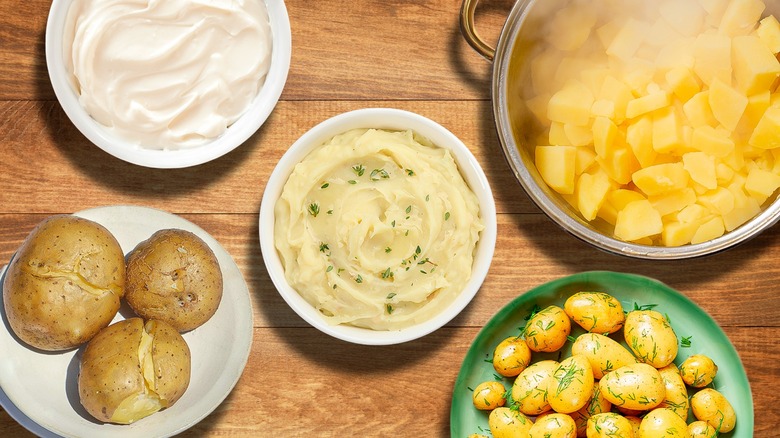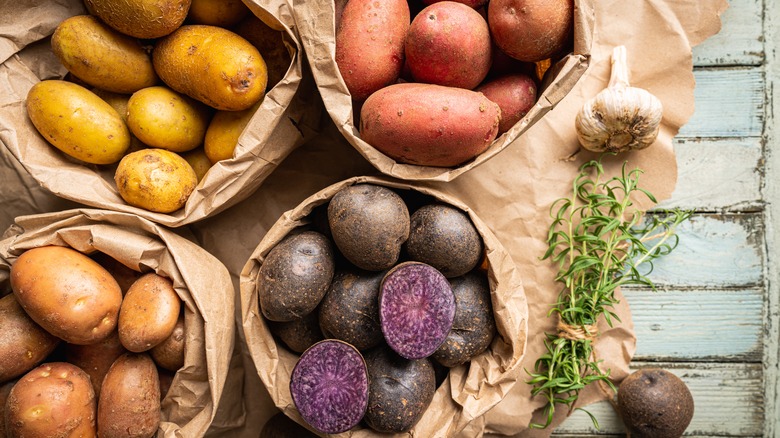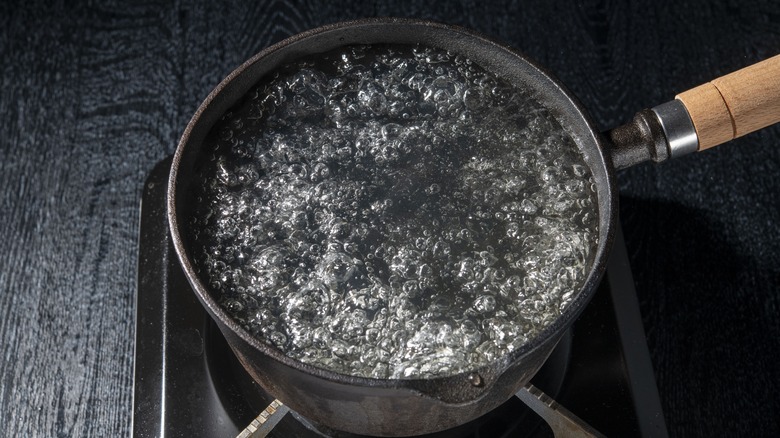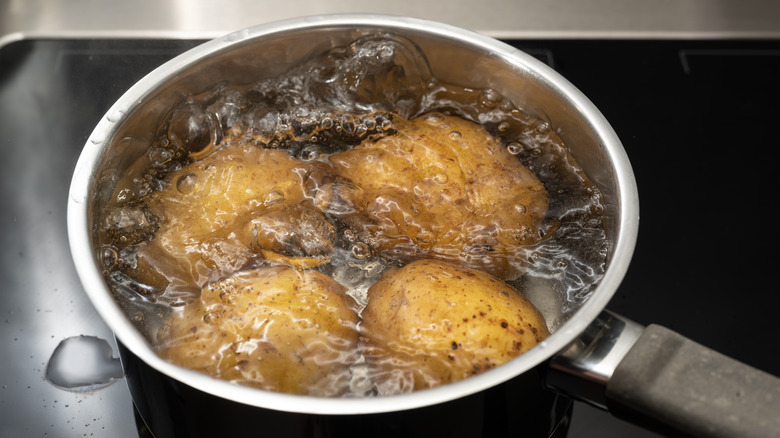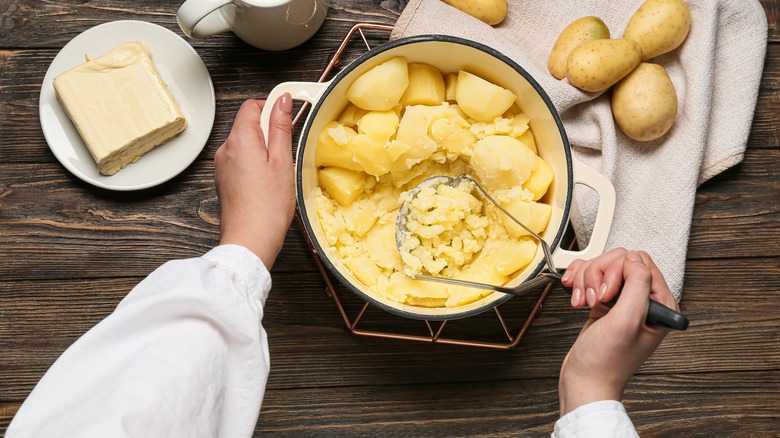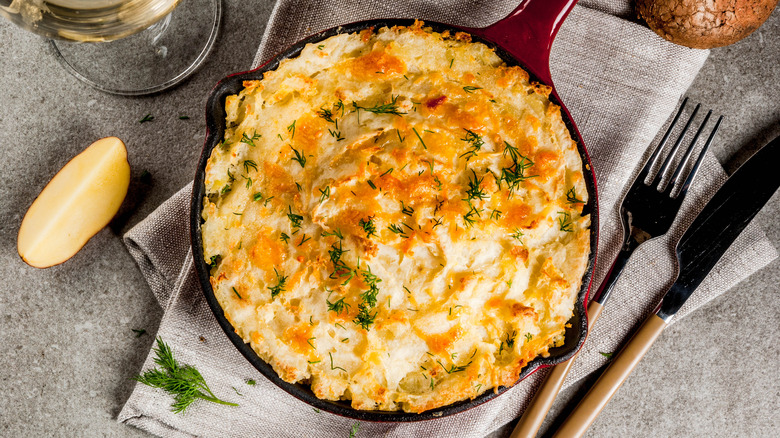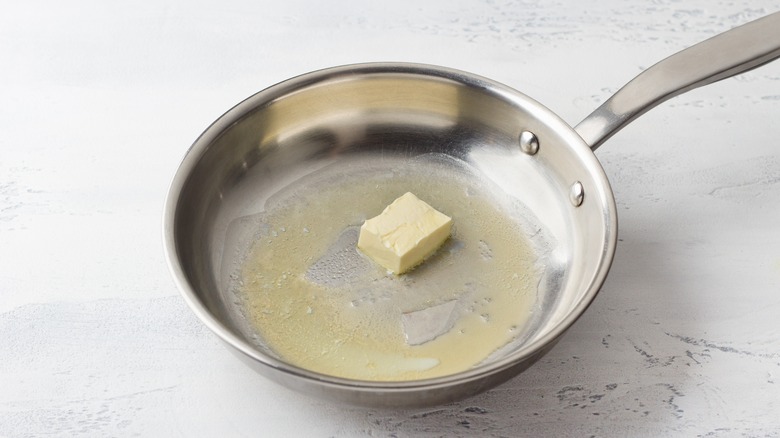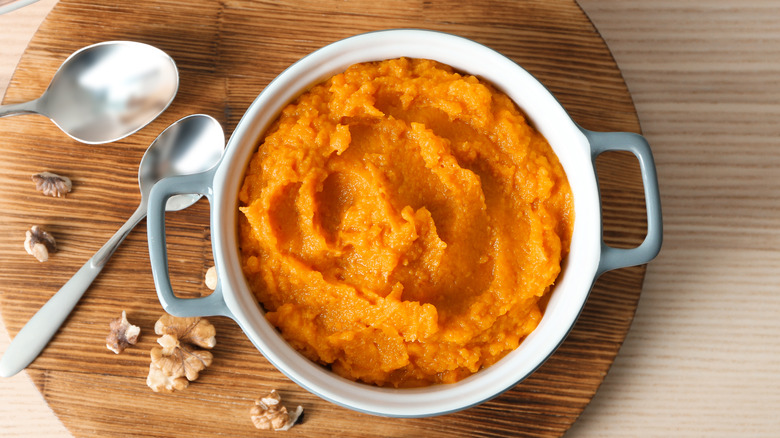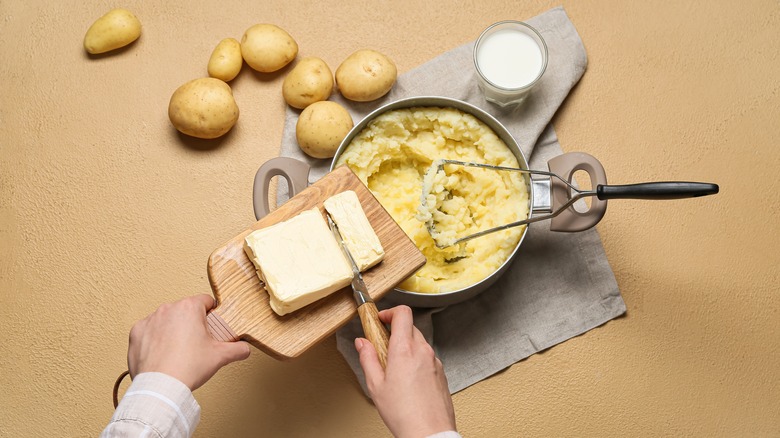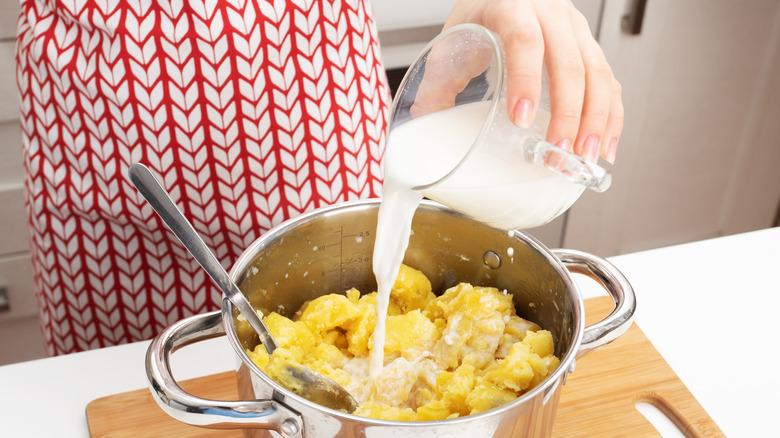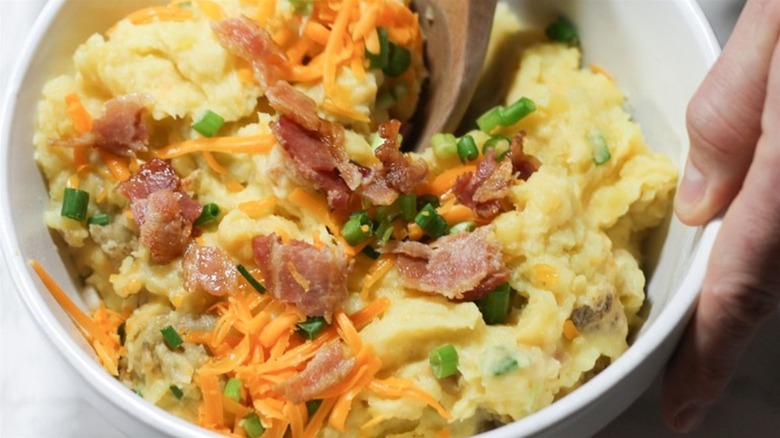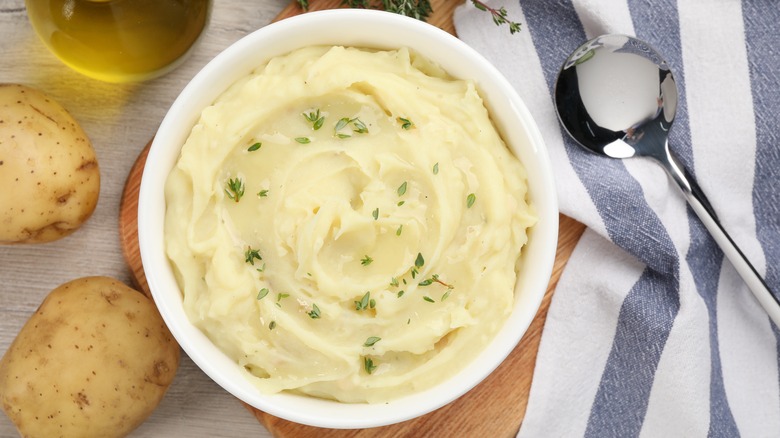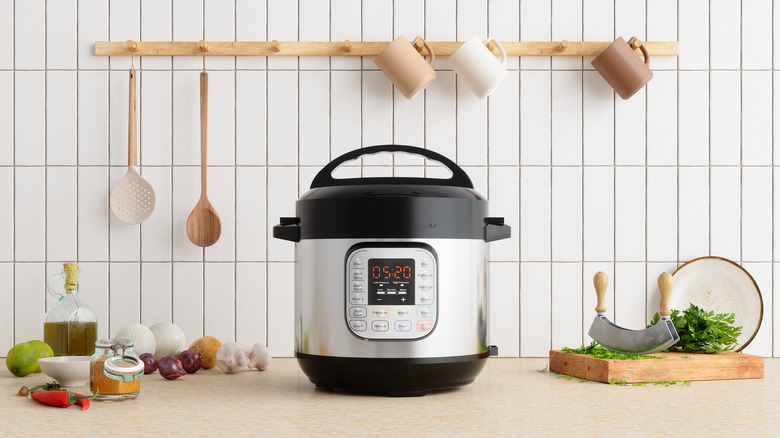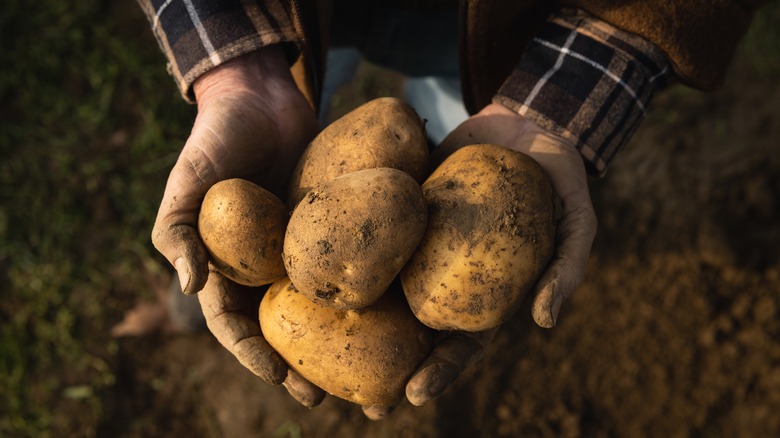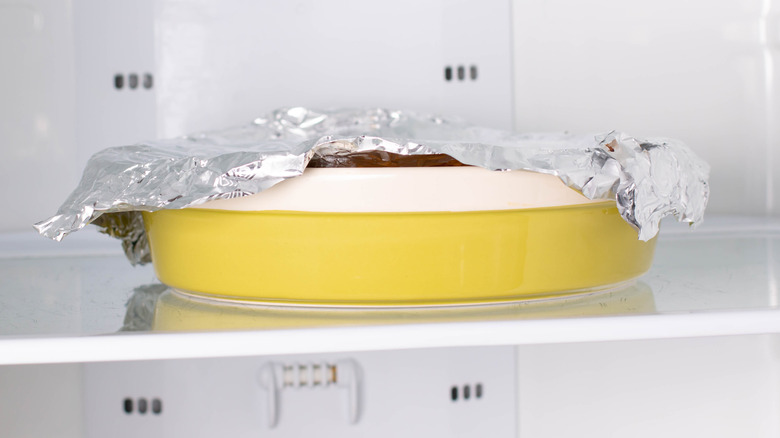Mashed Potato Myths You Should Stop Believing
Mashed potatoes are so ubiquitous that it's hard to imagine there could be anything we don't know about them. Whether you have a favorite family recipe that has been passed down for generations or one that you've adapted over time from a beloved cookbook or recipe blog, making this seemingly simple side feels like second nature for many of us. All you have to do is boil the potatoes, add some butter and cream, mash them, sprinkle them with salt and pepper to taste, and serve them hot.
No matter how much of a mashed potato pro you are, however, there is always something new to learn and misconceptions to dispel. Perhaps you've heard that boiling your potatoes whole is the best way to prevent them from becoming saturated with water, or that mashing them in a blender or a food processor is the best way to get a smooth consistency. These and other pieces of advice will actually do more harm than good, producing exactly the kind of uneven cooking and gluey consistency that most of us want to avoid. To ensure that your next mash is fluffy, rich, and full of flavor, we've rounded up some of the biggest myths standing between you and mashed potato perfection. Avoid these mistakes, and your potatoes will be in a league of their own.
Myth: The type of potato you use doesn't matter
Potatoes may seem like a simple enough starch, but there are differences between every type of potato that dictate which recipes they are best suited to and which they are not. In general, potatoes are either waxy (meaning they have a high water content) or starchy (meaning they have a high starch content). Waxy potatoes hold their shape when cooked, making them ideal for potato salads, while starchy potatoes are more prone to falling apart when cooked but provide a fluffy texture.
When it comes to mashed potatoes, fluffiness is paramount, especially considering there is no need for potatoes to hold their shape. Two of the most common varieties for mashed potatoes are russets and Yukon Golds. Russet potatoes are all-rounders. With a high starch content, they are perfect for mashing and baking, providing a floury texture and robust, crispy skin. Yukon Gold potatoes have a slightly lower starch content and a more buttery consistency. Both are delicious as mashed potatoes, but russets will yield fluffier results with an earthy flavor while Yukon Golds will provide a smoother texture and creamier flavor.
Myth: Water should always be used for cooking mashed potatoes
The first step in making mashed potatoes is cooking the potatoes. Most recipes call for water, possibly with a little salt, and few stray from this somewhat bland path. Boiling potatoes in water is such standard practice that most of us don't even think about other options. But if you want flavorful potatoes, you should start by cooking them in a flavorful liquid. Instead of heading for the tap, why not check your fridge and pantry for more exciting options?
A safe first port of call is broth. A carton of vegetable broth or chicken stock will go a long way in imparting some additional savory flavors to the potatoes even before you mash them. Chicken broth usually has a savory note that is not identifiable as meat, making it perfect for mashed potatoes. Keep in mind, however, that some vegetable broths err more on the side of sweetness than savoriness. Look for ones that are labeled as savory or those that are made predominantly with mushrooms.
Another option is to cook the potatoes in milk. During the cooking process, starchy potatoes soak up a significant amount of liquid, so you may as well make that liquid creamy and flavorful. Plus, it saves time and extra dishes. Once the potatoes are cooked, lightly mash them into the milk they were simmered in, add butter and seasonings, and they're ready to be served.
Myth: You should cook the potatoes whole on high heat
Even though it might seem like there is only one way to boil a potato, the subtle differences between methods will have a profound impact on the texture of your mash. Some recipes call for boiling the potatoes whole, suggesting that this is the only way to prevent them from becoming waterlogged and mealy. However, it can also cause them to cook unevenly, leaving the outer portions mushy and the inside raw. Slicing them into thin chunks will make them cook faster and more evenly. Just make sure to remove them from the heat as soon as they're finished so they don't absorb too much water.
Another way to avoid unevenly cooked potatoes is to start with cold water. Some recipes call for bringing the water to a boil before adding them, but this will cause the outsides to cook more quickly, even if you've cut them into chunks. Allow the potatoes to heat gradually with the water, and you will have consistent cooking throughout each piece. Keeping the water below boiling will also prevent the potatoes from falling apart.
Myth: There's no such thing as over-mashing
If you prefer smooth mashed potatoes to chunky ones, you might turn to the most obvious option: a blender or food processor. With their sharp, speedy blades, they make short work of any stray lumps in the mash, ensuring a silky, creamy consistency. However, if you've ever tried one of these methods, you probably ended up with a dense, gummy pile of spuds rather than a light, airy one. Sure, there might not have been any lumps, but the texture probably wasn't particularly tantalizing either.
The reason for the unpleasant texture is over-mashing. The more you work the potatoes, the more starch is released. Just as a tablespoon of flour or cornstarch can thicken gravies and sauces before your eyes, the starch in potatoes can cause the mash to turn so gluey it's almost elastic. Skip the blender and food processor, and rely on your own muscles to produce the desired results. A potato ricer is all you need for the job, allowing you to know exactly how much starch has developed. As soon as you hit the preferred texture, stop mashing.
Myth: Mashed potatoes are just a side dish
Mashed potatoes are the quintessential side dish. Unless your main dish is mostly made up of starch (spaghetti, for example), mashed potatoes go with just about everything. Whether you're barbecuing meat or making a vegetarian feast, a side of mashed potatoes will be the one menu item that everyone can get behind. But there are more ways to incorporate this crowd-pleasing dish into your meals. Instead of making it a supporting player, why not upgrade it to be the star of the show?
Shepherd's pie is a classic way to upgrade your mashed potatoes from side to main dish. Our Mexican shepherd's pie recipe puts a spin on the traditional formula with black beans, corn, zucchini, and chipotle peppers in adobo sauce. For a hearty, comforting option, try our rich and savory cottage pie recipe. Featuring a succulent sweet and savory filling of ground beef and vegetables in a rich sauce of red wine, tomato purée, and Worcestershire sauce, it is comfort food at its finest, with plenty of mashed potatoes on top to sop up the extra moisture.
Myth: The temperature of the butter doesn't matter
Once you've cooked the potatoes and mashed them, it's time to add the butter. Since potatoes are probably still steaming with heat, you don't need to worry about whether the butter is melted, cold, or even frozen. At least, this is what one might assume. However, as nit-picky as it sounds, the temperature of your butter really does matter. Making sure it's just right before you incorporate it into your potatoes will have a noticeable effect on the resulting texture.
Before adding butter, make sure it is fully melted. We're talking liquid rather than room temperature. Drizzling it into your mashed potatoes ensures that it will be evenly distributed and won't bring down the temperature of the potatoes. Even more importantly, however, starting with melted butter makes it much less likely that you'll over-mash the potatoes. Instead of trying to work hard butter into the mixture and waiting for it to melt, you only have to stir it slightly, and the less you have to work the potatoes, the lighter and less gummy they will be.
Myth: Mashed potatoes should always be savory
Just because they're being served alongside savory dishes doesn't mean that mashed potatoes always have to be savory. Sure, there is something heavenly about a smooth mash of Yukon Gold potatoes made with cream, garlic, butter, and a smattering of chives, but branching out will give you a whole new appreciation for contrasting flavors and the variety of potatoes you can buy.
To make a sweet mashed potato dish, you will, not surprisingly, need to start with sweet potatoes. With their abundance of natural sugars, you don't really need anything else aside from butter and cream, but a few additional ingredients will make them stand out even more. For a decadent, fall-inspired option, make sweet potatoes with a maple granola topping. A mixture of cinnamon, nutmeg, maple syrup, and granola gives the potatoes a crunchy texture and luxurious flavor that balances savory main dishes like meat and fish. For a simpler option, just add a tablespoon of maple syrup and a sprinkling of cinnamon with a handful of toasted nuts for a buttery crunch.
Myth: It's best to add milk and butter at the same time
Sometimes, cooking instructions can seem maddeningly contradictory. For example, over-mashing potatoes will make them gluey, but instead of adding the milk and butter at the same time to consolidate mixing, you should add them separately. This guidance might seem to be directly at odds, and yet, luckily, there is a way to reconcile them to produce delightfully fluffy, creamy mashed potatoes.
Adding melted butter before the milk or cream helps keep the potatoes from becoming gluey because the fat molecules in the butter coat the starch in the potatoes. By sealing in the starch, the butter prevents it from interacting with the liquid and becoming tacky and gummy. Once the butter has been gently mixed into the potatoes, add the milk a little at a time to avoid making the mixture too runny. You might prefer a stiffer consistency than the recipe calls for, and trying to remove liquid from mashed potatoes is a losing battle.
Myth: You should add the liquid before mashing
The first thing you might do after simmering the potatoes is add the butter and liquid before starting to mash. Adding liquid makes the potatoes smooth and creamy, but it doesn't make it any easier to mash them. In fact, adding the liquid before mashing is one of the biggest mistakes you can make. If you've ended up with gluey mash more often than not, adding the liquid after you've mashed the potatoes may single-handedly fix the problem.
When the starch in the potatoes interacts with liquid, it gets sticky, leading immediately to a gummy mash. The less time you can spend mixing the potatoes with liquid, the better, so making sure that all the mashing has been done before adding the butter, milk, or cream will cut out a lengthy period in which they could be interacting. You can even take the process further by drying the potatoes before mashing them to minimize liquid. If the potatoes are fully cooked, it will be easy to mash them with a ricer without the aid of liquid. Once they are free of lumps, stir in the melted butter so that it can coat the starch, and then add the warm milk or cream.
Myth: You should stick with traditional flavors
It's true that simplicity is sometimes best. However, with a dish as familiar as mashed potatoes, you can afford to dress it up sometimes for variety. Sure, a dollop of silky, buttery spuds with nothing besides a hint of cream and salt can be the perfect accompaniment to a rich, flavorful main dish, but when you want a side that livens up the meal, mashed potatoes can be surprisingly exciting.
Among the ingredients that will seriously upgrade your mashed potatoes are caramelized onions, nutmeg, and lobster (preferably not all together). As these options demonstrate, you can make your mash as simple or as decadent as you want. For luxuriously creamy mashed potatoes with a subtle tang, try our mascarpone mashed potatoes recipe. With just one extra ingredient, you can turn your starchy mash into a silky puree that still holds its shape. If you want to subtly change the flavor without affecting texture, try our parsnip and potato mash recipe. Sweet and earthy, parsnips are the perfect complement for potatoes without overpowering them.
Myth: You need dairy
Most mashed potato recipes include some form of dairy, which makes sense, because if you want a creamy, buttery mash, the most logical course of action is to use actual cream and butter. However, if you're avoiding dairy or cooking for someone who is, you don't need to resign yourself to a dry, dense, flavorless mash. There are many ways to make your potatoes smooth and tasty without dairy, and you're bound to find one that suits you.
An easy substitute for butter is vegan butter. Grocery stores are full of non-dairy spreads mimicking the texture and flavor of butter, and luckily, most of them work just as well. (For guidance on which option to buy, check out this handy cheat sheet from the folks at Tasting Table that ranks brands of vegan butter). When it comes to milk, there are even more options. Almond milk has a subtle flavor and light texture that is unobtrusive in mashed potatoes, while soy milk provides slightly creamier results. Just make sure to steer clear of plant milk with added sugar and vanilla.
Myth: You can't make mashed potatoes in an Instant Pot
We all know that Instant Pots are handy. Here at Mashed, we tried to narrow our best Instant Pot recipes to a single list and still couldn't get it below 95. To put it mildly, this kitchen appliance is versatile, efficient when compared to the oven, and easy to clean. Still, you might not have suspected that it could make mashed potatoes on top of everything else. That seems almost too good to be true.
As proof, we have not one, but two Instant Pot mashed potato recipes. Sure, making mashed potatoes requires some finesse if you're going to avoid gumminess and lumpiness, but with a few pointers, you can create the mashed potatoes of your dreams all in one (instant) pot. First off is this easy Instant Pot mashed potatoes recipe. Made with russet potatoes, vegetable broth, garlic, butter, cream cheese, and Greek yogurt, the resulting mash is creamy and full of flavor. And thanks to the magic of the Instant Pot, the recipe takes less than 15 minutes to complete.
For a more filling option, our recipe for Instant Pot loaded mashed potatoes could be turned into a main dish. Made with bacon, green onions, cheddar cheese, and sour cream, it is decadent, filling, and full of flavor.
Myth: Mashed potatoes are always unhealthy
Potato fans, rejoice. Despite constant assertions to the contrary, potatoes are not the one-stop-shop for all health problems. Yes, they are full of simple carbohydrates that aren't particularly filling, and they are often full of calories thanks to our penchant for eating them fried, but that does not mean they are necessarily unhealthy. After all, potatoes are vegetables, and buying them from the farmer's market or from the produce aisle is very different from purchasing them as part of a Happy Meal. When they are boiled or sautéed at home and served with healthy, filling accompaniments like beans or chicken, they can be part of a healthy diet, especially when they take the place of even simpler, more processed carbohydrates like white bread.
Potatoes also provide vitamin C, potassium, fiber (if you eat the skin), and, in the case of sweet potatoes, lots of vitamin A. If you want to make your mashed potatoes as healthy as possible, consider leaving the skin on, cutting back on the amount of butter you use, and swapping out cream for milk. You can also opt for sweet potatoes instead of white potatoes if you want an even greater nutritional boost.
Myth: You can't make mashed potatoes in advance
There are plenty of cooking myths you should never believe, such as the insistence that adding salt makes water boil faster or the notion that milk makes scrambled eggs light and fluffy. One of the most persistent misconceptions is that you can't make mashed potatoes ahead of time. This myth likely arose after people realized that microwaving previously fluffy, creamy spuds leads to a dangerously hot external temperature, an ice cold center, and jaw-gluing dryness. Luckily, such results are not inevitable.
There are several ways to reheat mashed potatoes without sacrificing texture. For starters, you can do it in the oven, covering them with foil to ensure they don't dry out and letting their temperature rise slowly so that the outside doesn't start to burn. Another option, if you can spare a little more hands-on time, is to mash the potatoes ahead of time but wait to add the milk until you're ready to serve them. Then, put the mashed potatoes in a saucepan over low heat and add warm milk to them until the mixture is smooth and piping hot. If you're in a hurry, you can use the microwave. Add extra liquid, such as milk or water, cover them, and heat them at 60-second intervals, stirring after each one.
Static Media owns and operates Mashed, Daily Meal, and Tasting Table.
